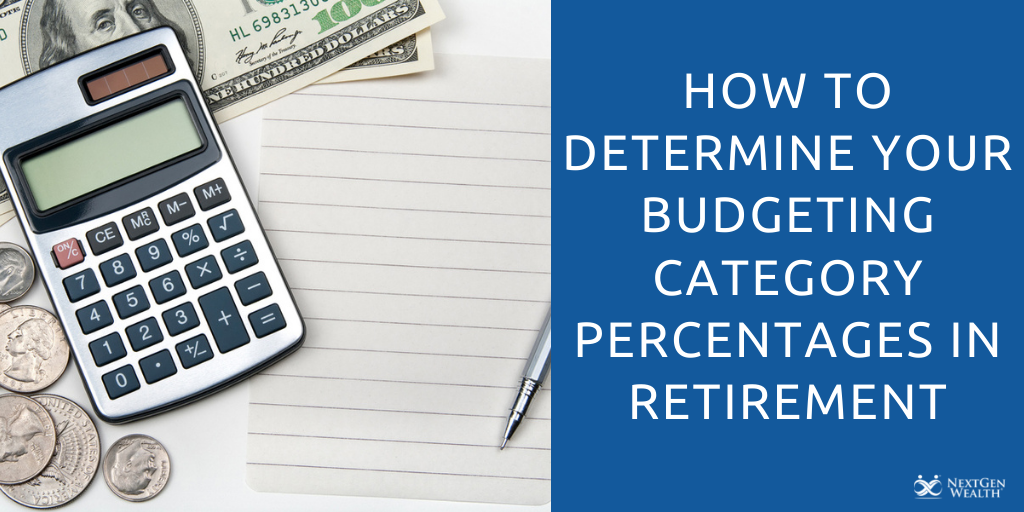How to Determine Your Budgeting Category Percentages in Retirement
If you are retired or getting close to retirement, chances are you are familiar with budgeting. There are many techniques for budgeting out there, but the basic idea is to balance your income and expenses. One way to do this is to think about your expenses as percentages. 
Budget percentages, as made popular by radio personality Dave Ramsey, help you understand where your money is going. The goal is simple: keep your expenses in each category within a certain percentage of your income. Most people who follow this method adhere to 10 common categories.
10 Common Budget Categories
In the following section, we will examine each of those 10 categories. We will also compare how they apply for working people versus retired people.
Housing
Paying for housing will usually take up the biggest portion of your income. Your mortgage or rental expenses make up this category. Experts advise keeping housing between 25% and 35% of your income or less, if possible.
Most people who work full-time pay rent or a mortgage. Some own their homes outright and therefore don’t have that recurring expense outside of property taxes.
For retired people, the goal is to keep costs low without negatively impacting their standard of living. By the time you retire, you may have paid off your mortgage. However, if you are paying for housing monthly, it is important to keep that cost below 35% of your income.
If your housing expenses are higher than that, you may need to look at options for lowering that cost. This might mean moving to a cheaper area or downsizing. Because housing takes up so much of your budget, it can quickly eat away your retirement funding.
Insurance
Insurance is the second-largest percentage category. It includes health, life, homeowners, and car insurance, plus any other insurance you may have. You should endeavor to keep these expenses between 10% and 20% of your income or less.
For retirees, insurance is important. The unexpected expenses that insurance typically covers can easily bankrupt you.
Health insurance is perhaps the most important for retirees to maintain. Aging usually brings health problems, and healthcare is expensive if you live in the United States.
Depending on your situation, your healthcare may be covered by the time you reach retirement. If you don’t have coverage at that point, however, you will need to take the cost of purchasing insurance into consideration.
In general, your insurance budget should be relatively fixed in retirement. From there you will know the minimum amount you will need to have available to cover your expenses.
Food
Your food budget is pretty self-explanatory. Unless there will be a significant change in your lifestyle after retirement, your food expenditure should stay about the same.
However, if there will be more or fewer people living with you after retirement, take that into consideration. You may also decide to change your eating habits, such as going out to eat more now that you have time.
You should try to keep your food expenses under 15% of your income.
Savings
Savings is something you may or may not worry about in retirement. For working people, experts recommend saving 10 to 15% of your income. At least part of those savings should be going toward retirement funding.
After retirement, those savings will be part of or all of your income. However, it would be wise to keep an emergency fund stocked up. Either way, you can expect to spend less on savings after retirement, so you can allocate the remaining percentage elsewhere.
Transportation
Transportation is the third and final 10 to 15% category. This includes the cost of commuting, such as gas and vehicle maintenance or public transportation fares.
After retirement, you can expect to spend less money on transportation as you will no longer be commuting. However, you may want to maintain this part of your budget if you plan on traveling. This way, you can budget for airfare or other transportation costs incurred while traveling.
Utilities
The utilities category takes up 5 to 10% of the ideal budget. This section is also pretty self-explanatory, as it includes all of your utility bills.
Unless you plan on moving, buying a second home or vacationing for long periods of time after retirement, this cost should stay the same. On the other hand, you may be paying slightly more for utilities if you are staying home more during retirement. Either way, this is another cost that should be stable enough to base your minimum budget on.
Entertainment
Entertainment should be another 5 to 10% of your budget. This category includes everything that isn’t necessary for survival. For example, you might go to the movies once a week or spend money on hobbies.
For people who work full time, entertainment probably won’t need to be a significant portion of their expenses. You spend a lot of your waking hours working, so there is less time to spend on entertainment.
After retirement, however, you will probably want to spend significantly more on entertainment now that you have free time. If you plan to pick up an expensive hobby, this is a good category to allocate more to, within reason.
Personal
The personal expenses category is also known as the miscellaneous category. This should be another 5 to 10% of your budget. Personal expenses can include gym memberships, classes, or hobbies if you don’t allocate those to entertainment. The personal category is like your pocket money, to spend on whatever you want.
Similar to the entertainment category, you may find you need to increase spending on personal expenses after retirement. Or, your spending may stay the same if you are only including things like membership dues, which you budgeted for pre-retirement.
Clothing
Clothing is, again, self-explanatory. This should take up the smallest portion of your budget at about 5% or less.
While working, you probably maintain a separate wardrobe for work. If this is a professional environment, work clothes can add up fast.
After retirement, you will probably only need one wardrobe. However, the amount you spend on clothing is up to your personal preferences. Your expenditure in this category should either go down or stay the same in retirement.
Debt
Debt is the tenth and final category, though some prefer to leave it off for one reason or another.
People working full time are likely to have some kind of debt. Student loans and credit card debt are very common. Mortgages and car financing are also common, but you may allocate them to the housing and transportation categories, respectively.
For retirees, most of your debt apart from mortgages and car payments will be paid off already. If not, you will probably still be working. Therefore, whether you include a debt category in your budget is up to you, and doing so will shift the percentages of the other categories.
How to Determine Your Budgeting Category Percentages in Retirement
Calculating all these percentages may seem complicated and difficult, especially when you don’t have exact figures. The best way to get started is to take note of your expenditures for a month or two.
If you are still working and trying to plan for retirement, use your current expenses and make realistic estimates for any changes that might happen after retirement. You will probably want to maintain your current standard of living if possible, so there shouldn’t be that many changes.
Once you take account of everything you spend money on and how much you spend on it, you can start organizing it. Divide all your spending into the categories listed in the previous section and add up the amounts spent in each category.
Then, find your net income, or your total income after taxes. This can include wages or pensions, rental income, business income and/or social security. You can probably use the net income listed on your last tax return if nothing has changed since then.
Finally, divide each category’s total expenditure by your net income. Adding up each category’s percentage should equal 100%.
Now you know your current category percentages, and all that’s left is to adjust your budget. For example, if you are currently spending 20% of your income on food, you will need to examine that category to find ways to cut back.
Creating and sticking to a budget can be difficult on your own, but it’s critical in order to stay afloat throughout retirement. NextGen Wealth can help you plan for the retirement you want. Contact us today for a free financial assessment.


